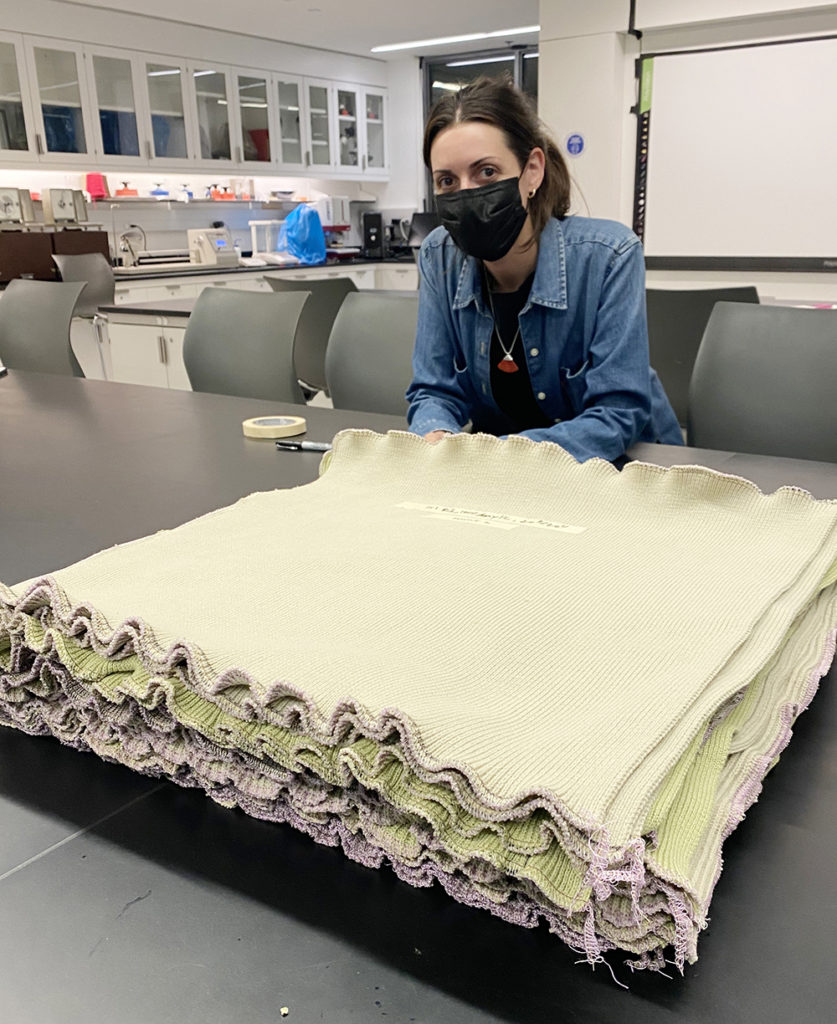More
Purpose/Impact
The winter knitwear market is dominated by acrylic, wool, and cashmere, none of which are produced in the U.S. However, cotton is domestically produced, and if it could replace wool-derived fabrics, would support local farmers and reduce the pollution created by global shipping. For cotton to fit this role, the team looked into cotton’s ability to be crimped to better mimic the structure of wool. To crimp the yarn, students first knit the cotton yarn, wash the knitted fabric, then undid the knit structure–or “de-knit”–the yarn, resulting in a crimp in the cotton. For this “Knit-de-knit” technique to work, students accounted for cotton’s shrinkage during the wash and chose a simple knit structure so it is feasible to de-knit. A crimped cotton fiber traps air (also called “dead air”), giving it insulating properties and allowing cotton to be a viable replacement for wool. With these techniques and the modified cotton yarn, students compared regular cotton, de-knitted cotton, wool, and acrylic yarn, testing the materials’ moisture absorption, thermal insulation, mechanical properties including fabric thickness, fabric weight, and fabric density.



Outcomes/Accomplishments
Employing all five knit structures, students created a multitude of samples for their research, and determined the fabric weight, fabric stitch density, fabric thickness, and moisture management tests in the lab. Additional samples of 1×1 Rib and Full Cardigan structures were prepared for the thermal and evaporative Resistance–dry test, conducted in an external lab. Students completed over 21,000 total manual feeds on the flatbed knitting machine to knit all of the required swatches.
Among five structures analyzed, the Half Cardigan structure represented the highest thickness for cotton yarns, whereas Full Cardigan structure was the thickest for wool and acrylic yarns. Between 1×1 rib and Full Cardigan structures, full cardigan represented better intrinsic thermal resistance. However, 1×1 rib with de-knitted cotton yarn exhibited more thermal resistance than with the regular cotton yarn. For all structures, de-knitted cotton yarns contained more favorable properties for winter wear (e.g., thicker, heavier) than the structures with regular cotton yarns.
STATUS UPDATE
The research results show de-knitted cotton yarn represents more favorable properties for winter wear than the structures with regular cotton yarn. However, further study is warranted to better compare the cotton yarn with classic sweater materials: wool and acrylic yarns. The thermal insulation properties can be improved by adding more washes before and after de-knitting and hence adding more crimps to cotton yarn. Students felt that the results would be more promising if they were able to use the same yarn sizes for all fiber types. The recommended way to conduct this project in the future would be using a Stoll electronic knitting machine (requiring little or no labor) with similar size yarns to have consistent knitted structures. Additional variables such as number of washes (2–4 washes) before and after de-knitting can be incorporated to have more promising results. Overall, this project gave students momentum to contemplate the benefit of using domestic cotton instead of foreign wool fibers in knit winter wear, for social and environmental good.




